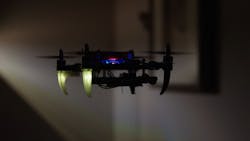It wasn’t all that long ago that what we now refer to as “smart” or “connected” home technology went by another name in the residential security industry – home automation. That term almost seems antiquated by today’s standards and indeed doesn’t fully encapsulate the capabilities that are offered by Internet of Things (IoT) devices.
I can remember walking the show floor in Atlanta at the first CEDIA Expo I attended in 2009. The industry mindset at that time reflected that this high-end functionality was reserved predominantly for the wealthy who could afford big bucks for such amenities as remotely opening and closing curtains or dimming lights throughout their residence. But even using a remote seems archaic in today’s landscape where appliances and alarm systems can be turned on or off via voice command.
To see just how far the industry has come in a relatively short time, one only has to look at the annual Consumer Electronics Show in Las Vegas. Home security solutions, which used to only comprise a small number of the thousands of products launched each year at the show, are now one of the main attractions. Here a just a few of the announcements making waves at this year’s show.
Artificial Intelligence Takes Hold
While the use of artificial intelligence and machine learning software is still in its relative infancy in security, several companies are already laying the groundwork for its adoption in the residential sector.
Vivint this week announced the debut of “Sky,” a smart home assistant that leverages artificial intelligence to automatically manage connected devices within a consumer’s home. Sky can even use data from sensors and devices within a residence to detect when a homeowner is present which enables it to lock doors and arm a security system automatically. It also has the ability to learn the daily routines of a homeowner to manage and adjust temperature and security settings without the user having to do anything. Sky can communicate with customers through the Vivint Smart Home app and the Vivint SkyControl panel and can also take voice commands through Amazon’s Alexa.
“Consumers want more than an intelligent device – they want an intelligent home,” said Matt Eyring, chief strategy and innovation officer at Vivint Smart Home. “The real magic comes when multiple devices work together throughout the home in an intelligent way, creating a single, cohesive experience.”
Not to be outdone, Alarm.com launched its “Insights Engine” machine-learning technology this week at CES. Insights Engine also has the ability to identify behavior/activity patterns and insights from connected devices and sensors within a home to “learn” the routines of customers and subsequently take actions on their behalf.
The company said the first application of the technology will be for a new category of intelligent awareness notifications that can alert families to potential safety or security issues around their home all without them having to create custom rules or notifications. For example, a home’s front door may be frequently opened and closed on weekday mornings as family members leave for work or school. However, on weekends, the front door may not be opened until later in the day. Using Insights Engine in this type of scenario, if the front door of the home was opened earlier than typical on Saturday by children, for instance, going outside to play, an unexpected activity notification would be sent to the homeowner to let them know that.
“Alarm.com has always aggregated sensor data to create an intelligent, proactive and contextually aware smart home experience,” said Dan Kerzner, Alarm.com’s chief product officer. “The Insights Engine is an example of how we are extending that approach with machine learning to define the next generation of smart home solutions.”
The Eye in the Sky
Unmanned aerial vehicles (UAVs), or drones as they are commonly referred to, have already made a significant impact on the security industry in general and now it seems they will soon be making their way into home and small business security applications.
Alarm.com announced at the show that it is partnering with Qualcomm to develop an autonomous, video-enabled drone that can investigate suspicious activity on the property of home and business owners. The company said it intends to leverage its’ aforementioned “Insights Engine” technology to be able to detect anomalies in activity patterns on a customer’s premises and intelligently deploy the drones to locations where unusual activity is detected or an alarm is triggered. Customers will also have the ability to share video from the drones with central monitoring stations and emergency responders.
“Our intelligent drone deployment system will be designed to provide targeted video in response to specific events around a property - augmenting fixed location cameras and enhancing the active security perimeter for homes and businesses,” added Kerzner.
“This is a very interesting application for drones, which at their core are essentially flying cameras, and by using other advanced capabilities of our Snapdragon processors, Alarm.com is designing a whole new way to provide security to properties,” said Hugo Swart, senior director, product management, Qualcomm Technologies, Inc. “The Qualcomm Snapdragon Flight platform pushes the boundaries of the drone industry and has led to many new form factors and use cases, and Alarm.com, with its security expertise, is taking commercial and residential security systems to the next level by integrating intelligent and cutting edge drones to its solutions.”
ADT Integrates with Amazon’s Alexa
By now, most everyone is familiar with Alexa, Amazon’s virtual personal assistant that enables users to control certain smart devices throughout their home via voice commands. Residential security giant ADT this week announced that Amazon’s Echo and Echo Dot products are now a part of its Pulse ecosystems, providing customers with the ability to leverage Alexa to arm and disarm their home security system through voice commands and a secure PIN.
ADT will also begin offering Alexa devices directly to new and existing customers, facilitating product setup and additional support for those who purchase the device through ADT.
“Incorporating Amazon Alexa devices into our offerings is the perfect example of people and technology coming together to ensure our customer’s smart home is a safe home,” said Jamie Haenggi, chief marketing officer, ADT. “Amazon’s vision to simplify the home automation experience through voice-enabled action matched perfectly with ADT’s passion for security and customer service, providing us an exciting opportunity to extend our footprint in the security and automation space.”
In addition to using voice control to lock and unlock the door, turn on the lights, arm/disarm the security system and more, ADT Pulse users can also ask Alexa to provide the status of their home security system and automation devices. Once a command is given to Alexa, she will provide feedback to confirm the action has taken place.
Easier Smart Home Integrations for Dealers
Earlier this week we covered an announcement from Sigma Designs, the maker of wireless Z-Wave chips, which has introduced an enhancement to the specification called “Z-Wave SmartStart,” which promises to save installers of smart home technology a substantial amount of time and effort when it comes to getting connected systems up and running. According to Raoul Wijgergangs, vice president Z-Wave for Sigma Designs, the company realized there was a need in the market for a solution that could help operators – security installers and monitoring companies, telecommunications providers and cable firms – reduce the amount of time their techs spend setting up smart home systems and SmartStart is a way to help them achieve this.
“To do (the entire install) for (customers) involves a lot of installation – locks, thermostats, routers, etc. – and Z-Wave SmartStart is all geared toward helping these operators get these installations done faster,” he adds. “As soon as (SmartStart) devices are powered up by the installer, they show up at the gateway which says, ‘Ok, here is the whitelisted device I knew was going to be a part of this network.’”
Click here to read the full story.



